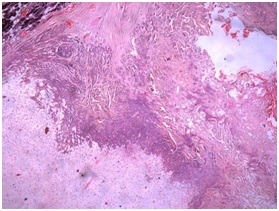Histomorphological spectrum of salivary gland tumors: a study at tertiary care teaching hospital of North Gujarat
Abstract
Background: Salivary gland tumors (SGTs) are rare neoplasm of head and neck region. The salivary gland tumours vary widely in histopathological appearance. Also, epidemiological data of these tumors in various parts of the world are different. And so the study of SGTs for their biology and clinical characteristics can be helpful for a better understanding.
Objectives: The objective of this study was to study types and new entities, common site of distribution and histomorphological spectrum of salivary gland tumors (SGTs).
Materials and Methods: It was a retrospective followed by prospective study. Pertinent clinical history like age, duration of the lesion, site of the lesion, significant family and personal history, history of associated diseases was recorded. Specimens consisted of incisional biopsies were examined microscopically by the expert pathologist. Details of specimens noted in Performa include dimensions, appearance of external and cut surface and presence of lymph nodes, their size and number.
Observations: Total 70 cases of SGTs could be included in the study. Among them 56 (80%) were benign and 14 (20%) were malignant. Parotid is commonest salivary gland involved with 75.71% of all tumors, followed by submandibular with 21.42% and minor salivary glands with 1(1.4%) of salivary gland tumors. among benign tumors Pleomorphic adenoma is most common with 70% of all benign SGTs followed by Warthin tumors (7%). Among malignant tumors commonest is Mucoepidermoid carcinoma with 14.28% of all SGTs. Female preponderance was clearly found in malignan at SGTs.
Conclusion: Parotid is most common site for the SGT. And pleomorphic adenoma and the Warthin tumors are the common benign tumors involve parotid gland the most. Among malignant tumors mucoepidermoid carcinoma are the commonest with female preponderance. While other carcinoma like adenoid cystic carcinoma and SCC are also common.
Downloads
References
2. Auclair PL, Ellis GL, Gnepp DR. (eds) Salivary gland neoplasms: general considerations. In: Ellis GL, Auclair PL, Gnepp DR. Surgical pathology of the salivary glands. Major problems in pathology. Saunders, Philadelphia, 1991, p.135 -164.
3. Ahmad S, Lateef M, Ahmed R. Clinicopathological study of primary salivary gland tumors in Kashmir. JK-Practitioner 2001;9:231-3.
4. Fletcher CDM. Tumors of salivary glands. In: Christopher D.M. Fletcher. Diagnostic histopathology of tumors. 4th edi., 2013. P. 273-75,285.
5. Brandwein MS, Ivanov K, Wallace DI, Hille JJ, Wang B, Fahmy A, et al. Mucoepidermoid carcinoma: A clinicopathologic study of 80 patients with special reference to histological grading. Am J Surg Pathol2001;25:835-45.[pubmed]
6. Batsakis JG, Luna MA, El-Naggar A. Histopathologic grading of salivary gland neoplasms: III. Adenoid cystic carcinomas. Annals of Otology, Rhinology & Laryngology. 1990 Dec;99(12):1007-9.
7. Sando Z, Fokouo JV, Mebada AO, Djomou F, NDjolo A, Oyono JL. Epidemiological and histopathological patterns of salivary gland tumors in Cameroon. Pan Afr Med J. 2016;23:66.
8. Nandakumar A, Ramnath T, Roselind FS, Shobana B, Prabhu K. National Cancer Registry Programme, Indian Council of Medical Research. Bangalore: Co-ordinating unit, NCRP (ICMR); 2005. Two year report of population based cancer registries 1999-2000; pp. 160–95.
9. Shanta V, Swaminathan R, Nalini J, Kavitha M. National Cancer Registry Programme, Indian Council of Medical Research. Bangalore: Co-ordinating unit, NCRP (ICMR); 2006. Consolidated report of population base cancer registries 2001-2004; pp. 135–53.
10. Rajdeo RN, Shrivastava AC, Bajaj J, Shrikhande AV, Rajdeo RN. Clinicopathological Study of Salivary Gland Tumors: An observation in tertiary hospital of central India. Int J Res Med Sci 2015;3:1691-6.
11. ZohrehJaafari-Ashkavandi, Mohammad-Javed Ashraf, Maryam Moshaverinia, . Salivary gland tumors: a clinicopathological study of 366 cases in southern Iran.[pubmed]
12. Elagoz S, Gulluoglu M, Yilmazbayhan D, Ozer H, Arslan I. The value of FNAC in salivary gland lesions. J Otorhinollaryngol. 2007:69(1):51-6.[pubmed]
13. Vargas PA, et al. salivary gland tumors in Brazilian population: a retrospective study of 124 cases. Rev Hosp Clin Fac Med S Paulo 2001; 57(6):271-6.[pubmed]
14. Shrestha S, Pandey G, Pun CB, Bhatta R, Shahi R. Histopathological pattern of salivary gland tumors. Journal of pathology of Nepal 2014;4:520-24.
15. Stewart CJR, Mackenzie K, McGarry GW, Mowat A. Fine needle aspiration cytology of salivary glands: A review of 341 cases. Diagn Cytopathol. 2000; 22:139-46.[pubmed]
16. Rajesh Singh Laishram, K Arun Kumar, Gayatri Devi Pukhrambam, Sharmila Laishram, and Kaushik Debnath. Pattern of salivary gland tumors in Manipur, India: A 10 year study. South Asian J Cancer. 2013;2(4):250–253.
17. Isacsson G, Shear M. Intraoral salivary gland tumors: a retrospective study of 201 cases. J Oral Pathol. 12: 57-62, 1983.[pubmed]
18. Spiro RH, Koss LG, Hajdu SI, Strong EW. Tumors of minor salivary origin. A clinicopathological study of492 cases. Cancer. 31: 117-129, 1973. [pubmed]
19. Rivera-Bastidas H, Ocanto RA, Acevedo AM. Intraoral minor salivary gland tumors a retrospective study of62 cases in a Venezuelan population. J Oral Pathol Med. 25: 1- 4, 1996.[pubmed]
20. Van Der Wal JE, Snow GB, Van Der Wal I. Histological new classification of 101 intraoral salivary gland tumours. J Clin Pathol. 45: 834-835, 1992.[pubmed]
21. Shreedevi S Bobati, B V Patil, V D Dombale. Histopathological study of salivary gland tumors. J Oral MaxillofacPathol. 2017 Jan-Apr; 21(1): 46–50.
22. Subhashraj K, Salivary gland tumors: A single institution experience in India, Br J Oral Maxillofac Surg (2008), doi:10.1016/j.bjoms.2008.03.020.[pubmed]
23. Pinkston JA, Cole P. Incidence rates of salivary gland tumors: Results from a population-based study. Otolaryngol Head Neck Surg. 1999;120:834–40.[pubmed]



 OAI - Open Archives Initiative
OAI - Open Archives Initiative


